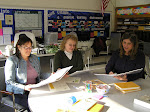Though the origin of Readers’ Theatre may be traced back to Greece 2,500 years ago and also found in medieval times, they more recently have evolved from group readings in the early nineteenth century. The earliest use of the term Reader’s Theatre dates back to 1945 when a professional group in New York who called themselves Readers Theatre, Inc., produced Oedipus Rex. Their stated purpose was “to give the people of New York an opportunity to witness performances of great dramatic works which were seldom if ever produced.”
In 1951, a production of Don Juan in Hell, originally written by George Bernard Shaw, was performed using four well-known actors. The performers sat on stools and appeared to read from scripts placed on lecterns, but it was obvious they had memorized the material.
In 1952 Stephen Vincent Benét’s long narrative poem John Brown’s Body, adapted and directed by Charles Laughton, was presented by three readers and a chorus of twenty. Unlike the actors in Don Juan in Hell, who read the part of many different characters, these three actors each represented a single character. Critics and audience members recounted how each was able to come away with his/her own vision of the narrative because the staging left so much up to the imagination.
It should be noted that radio plays are, of course, a form of Readers’ Theatre. The actors perform using scripts. There is no “staging” in this case. This form of drama began in the twenties and reached its peak in the forties.
The first musical to be done professionally in Readers’ Theatre style was You’re a Good Man, Charlie Brown, opening March 7, 1967. Generally the term “Readers’ Theatre style” refers to productions where the staging and movement is minimal and representative, while the scripts (either present or absent) are memorized.
During the sixties, Readers’ Theatre became popular within college theatre departments and from there spread into secondary English education. These graduates would bring the practice into their high school English classroom. But more recently, educators have discovered, what I call, the literacy factor, and so Readers’ Theatre has moved into middle and elementary schools.
Adapted from Coger, Leslie Irene and Melvin R. White. Readers Theatre Handbook, a Dramatic Approach to Literature. Revised Ed. Glenview, IL: Scott, Foresman and Co., 1973.
Monday, March 10, 2008
Subscribe to:
Post Comments (Atom)

1 comment:
This is a great article! Thank you for making it available.
Post a Comment